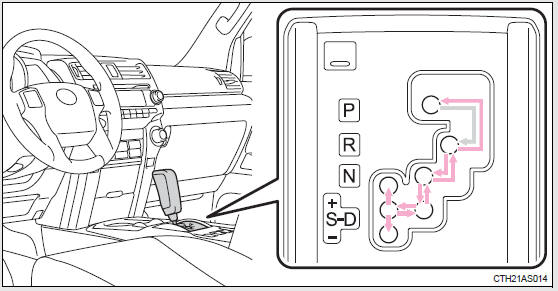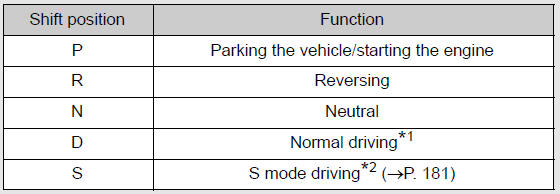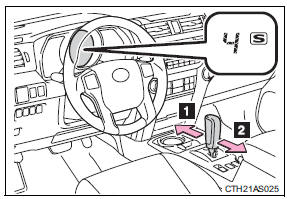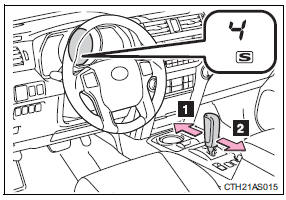Toyota 4Runner: Automatic transmission
Select a shift position appropriate for the driving conditions.
Shifting the shift lever

 Vehicles without a smart key
Vehicles without a smart key
system:
While the engine switch is in the “ON” position, move the shift lever with the brake pedal depressed.
Vehicles with a smart key system:
While the “ENGINE START STOP” switch is in IGNITION ON mode, move the shift lever with the brake pedal depressed.
When shifting the shift lever between P and D, make sure that the vehicle is completely stopped.
Shift position purpose

*1: To improve fuel efficiency and reduce noises, set the shift lever in the D position for normal driving.
*2: Selecting shift ranges using S mode restricts the upper limit of the possible gear ranges, controls engine braking forces, and prevents unnecessary upshifting.
Changing shift ranges in S mode
When the shift lever is in the S position, the shift lever can be operated as follows:
Non-Optitron type meter

1. For upshifting
2. For downshifting
Optitron type meter

1. For upshifting
2. For downshifting
The initial shift range in S mode is set automatically to “4” according to vehicle speed. However, the initial shift range may be set to “3” if AI-SHIFT has operated while the shift lever was in the D position.
Shift ranges and their functions
• You can choose from 5 levels of engine braking force.
• A lower shift range will provide greater engine braking force than a higher shift range, and the engine speed will also increase.
S mode
When the shift range is “3” or lower, holding the shift lever toward “+” sets the shift range to “5”.
AI-SHIFT
AI-SHIFT automatically selects the optimal gear according to driver performance and driving conditions.
AI-SHIFT automatically operates when the shift lever is in the D position.
(Shifting the shift lever to the S position cancels the function.) The engine speed may remain high after releasing the accelerator pedal.
This does not indicate a malfunction.
When driving with the cruise control system
Engine braking will not occur in S mode, even when downshifting to “4”.
If the shift lever cannot be shifted from P
If the “S” indicator does not come on even after shifting the shift lever to S
This may indicate a malfunction in the automatic transmission system. Have the vehicle inspected by your Toyota dealer immediately.
(In this situation, the transmission will operate in the same manner as when the shift lever is in D.)
Downshift restriction warning buzzer (S mode)
To help ensure safety and driving performance, downshifting operation may sometimes be restricted. In some circumstances, downshifting may not be possible even when the shift lever is operated. (A buzzer will sound twice.)
CAUTION
When driving on slippery road surfaces
Do not accelerate or shift gears suddenly.
Sudden changes in engine braking may cause the vehicle to spin or skid, resulting in an accident.
 Engine (ignition) switch (vehicles with a smart key system)
Engine (ignition) switch (vehicles with a smart key system)
Performing the following operations when carrying the electronic key on
your person starts the engine or changes “ENGINE START STOP” switch modes.
Starting the engine
Check that the parking b ...
 Turn signal lever
Turn signal lever
The turn signal lever can be used to show the following intentions of the
driver:
1. Right turn 2. Left turn 3. Lane change to the right (push and hold the
lever partway) The right hand signals ...
Other materials about Toyota 4Runner:
Cruise control
Use the cruise control to maintain a set speed without depressing the
accelerator pedal.
1. Indicators
2. Cruise control switch
Setting the vehicle speed
Press the “ON-OFF” button to activate the cruise control.
Cruise control indicator will co ...
Diagnostic Trouble Code Chart
DIAGNOSTIC TROUBLE CODE CHART
HINT:
If a trouble code is output during the DTC check, inspect the trouble areas listed
for that code. For details of the code, refer to the "See page" below.
Sliding Roof System
DTC Code
Det ...
0.0132
